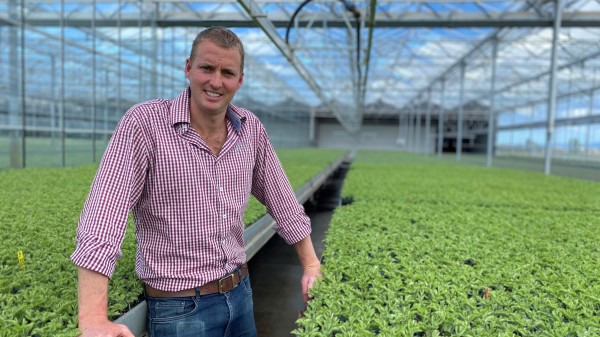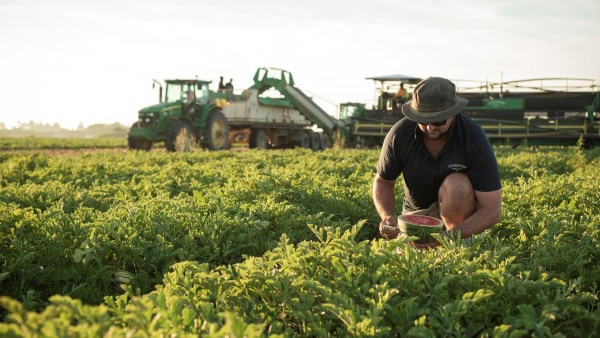Loved by consumers but tricky to grow, LeaderBrand is busy investing in a domestic watermelon crop to produce a delicious, sustained supply for the local market. Kristine Walsh speaks to LeaderBrand’s Gisborne team on the company’s renewed interest in the crop and the challenges and opportunities it brings.
There was a time when LeaderBrand general manager of farming, Gordon McPhail, took care of growing the company’s watermelons himself – a task he says was all but easy.
“Watermelons can be a very fickle crop, and if things go wrong, you can lose an entire paddock overnight,” Gordon says. “That’s why our cropping manager, Andrew Rosso, takes care of that now. It’s a matter of playing to your strengths.”
Watermelons aren’t a new crop for Leaderbrand’s Gisborne team. The company grew them until 2019, when the decision was made to stop growing them while they focused on developing other branches of the business and supporting infrastructures, such as LeaderBrand’s new distribution center in Gisborne city and a major covered cropping facility just out of town.

LeaderBrand general manager of farming, Gordon McPhail, says the company’s aim is to grow the watermelon market while growing volumes sustainably
“The watermelons do need a lot of care, attention, and investment, so at the time, we decided to devote our resources to our expanding salad business, as we saw getting this right first as being crucial,” Gordon says. “But with the business on track and a renewed focus on our value-added products, we decided the 2021–2022 season was the right time to get back into supplying [watermelons to] our domestic market.”
Gisborne’s long sunshine hours, high number of heat units, and fluctuations between day and night temperatures really brings sugar levels up. Gordon says this makes Gisborne one of the best regions in the country to grow watermelons.
But the product is not without its challenges, a big one being the prevalence of the fungus Fusarium, a destructive problem for growers around the world.
“The issue for us is that the Fusarium that affects watermelons is the same [fungus] that affects squash,” Gordon says. “Both [watermelons and squash are] from the cucurbit family. With squash being a large part of our business for many years, our soil has a high risk of infection. With that increased risk of disease, we had to make sure we kept on top of our research and did the work at nursery and ground prep [sic] stage to minimize any potential for that.”
Even though LeaderBrand has a history of growing watermelon, it put testing and development at the center of its market re-entry. “Our aim is not only to grow the best produce but to work hard to ensure consistency of supply,” Gordon says. “So, while we did supply the market last season, our main focus was on research and experimentation to ensure we could get a good supply of great product for a sustained period of time.”

The team invested in a great deal of background research, including traveling the world to learn grafting and growing techniques that could be developed into their own pioneering methods while avoiding disease.
“We did that before 2019, and the investment and management required was one of the reasons why we put watermelons aside for a couple of years while we focused on areas like the salad side of the business,” Gordon says. “We wanted to make sure we could give the melons the attention needed to grow them really well, but made it clear to our customers that we weren’t out for good… just taking a break.”
A renewed focus on the domestic market has helped LeaderBrand hone its approach.
“While we are looking at producing 3000 tonnes a season now, our aim is to grow the market and grow the volume to meet it sustainably,” Gordon says. “But we have to earn the right to do that by growing good varieties and handling them well, so consumers get the best possible eating experience, and by offering our customers – the supermarkets – consistency of supply.”
Like other Gisborne growers, LeaderBrand had a tough 2021–2022 season. Watermelons are generally planted by the first week of October, and in November, the region was hit by catastrophic rain.
“There were challenges around timing, but we still managed to reintroduce ourselves to the market with good volumes and great quality product while carrying out the experimentation needed to take us into the next season,” Gordon says. “Even though more rain has made for late planting this year, the trials we did the previous season have given us great confidence in our growing program going into the summer of 2022–2023.”
Four varieties of watermelon will be produced in this year’s summer program – a couple of the large, striped Jubilee-style melons; and a couple of smaller hybrid “micro-seeded” varieties, known for their small seeds and dense flesh.
“The reality is that while many buyers love the huge, eight-kilogram melons, others prefer something a bit more manageable,” Gordon says. “This way, we get to cater to both sides of the market to ensure everyone has a great experience.”
Green gold
Once harvested through January and February, all will be treated like green gold, with LeaderBrand well set up to handle them at its post-harvest facility that is also used for squash.
Gordon says gentle handling is key. The melons are hand-picked when ripe and placed – again by hand – onto a belt to be brushed, washed, dried, graded, and packed, and all floated through the water to ensure they emerge undamaged.
“We value our brand, so it’s part of offering reassurance to the customer that when they pick up a LeaderBrand melon, it’s going to be the best they can get,” says Gordon. “It also builds a real sense of ownership for our team when they know they are putting out the best quality product.”
Achieving the best quality comes down to spending time investing in trials, selecting the right varieties, planting in the right soils and conditions, and treating the melons right post-harvest, Gordon says.
“For us, they’re an exciting product where there is huge potential to develop new varieties, while the category is one that fits really well with our business and supply model.
“And at the end of the day, who doesn’t love a good watermelon?”
For more information
HortNZ
www.hortnz.co.nz
